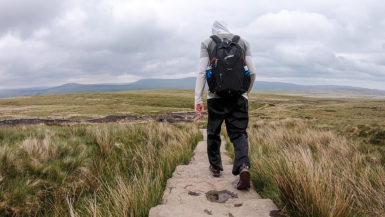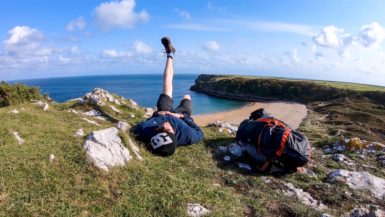A Hiking Guide to Preikestolen (Pulpit Rock, Norway)
6 Minute Read
In this travel guide I’m going to tell you how to hike Preikestolen – also known also as the Pulpit Rock, Norway. This is an incredibly popular hike in the Westfjords of, you guessed it, Norway.
The rock is characterised by an enormous granite slab 604 metres high. There is a sheer drop down the rock to the waters of Lysefjorden below.
Due to the spectacular views across the fjord and of the surrounding mountainous landscape, Pulpit Rock is undeniably one of Europe’s natural wonders.
Hikers, walkers – and even base jumpers – flock from all over the world to climb to the top of this soaring monolith.
This Pulpit rock, Norway guide will include:
- What is it?
- Where Does it Start and Finish?
- How Long Does it Take to Hike?
- What is There to See?
- How to Get There?
- What to Pack?
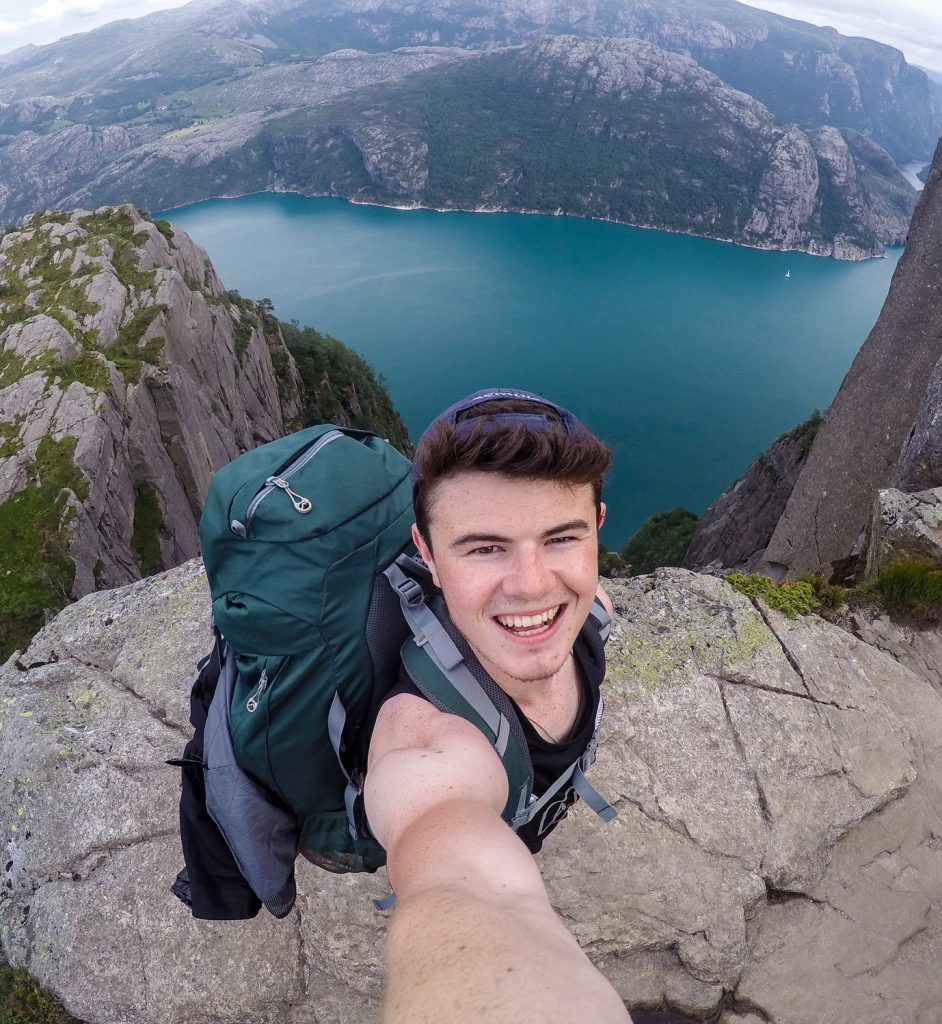
This page contains affiliate links. This means I make a commission if you buy a product I have recommended (at no extra cost to you). All recommendations I give are genuine and my own. Thanks for the support!
See also:
10 Hiking Safety Tips
10 Beginner’s Hiking Tips
1. What is Pulpit Rock, Norway?
The rock is thought to have formed at least 10,000 years ago during an ice age. Glacial action carved out the fjord leaving this slab untouched at the top.
The rock was originally called Hyvlatonnå – which in Norwegian is the name for the tooth of a woodworker’s plane tool. The name was then officially changed to Preikestolen which translates to Pulpit Rock in English.
The smooth slab on top of Pulpit Rock, Norway is 25 x 25 metres. What is so shocking is how sharp and steep the drop is off the side. The edge is so angular that it’s easily possible to sit on the corner of the rock with you feet swinging in the air below you.
At its base is the 26-mile-long Lysefjorden – meaning light fjord in English. The fjord is connecting to the sea and is filled with salt water. Despite being enormous and looking like an ocean, it is surrounded by giant granite mountains on all sides creating an out-of-this-world landscape.
The only way to reach Pulpit Rock, Norway is by hiking to the top. There’s no car park, elevator, cafe, or souvenir shop up there. Just step after step to the summit!
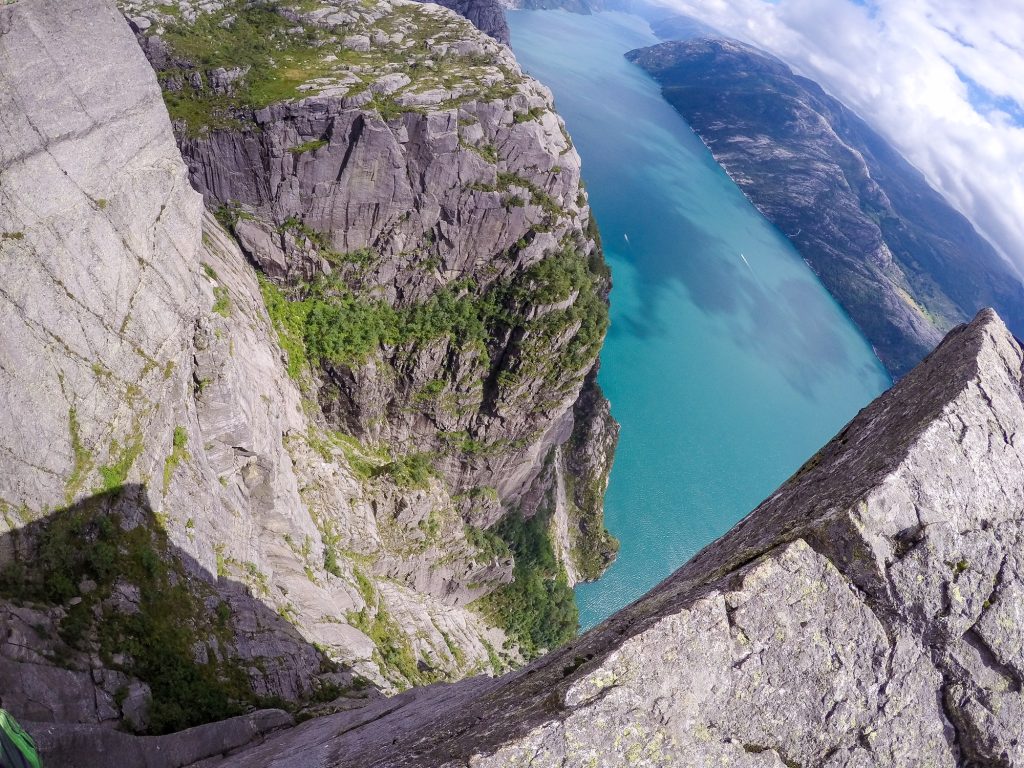
2. Where Does Pulpit Rock, Norway Start and Finish?
The trail is an out and back route. The path begins at the Preikestolen Fjellstue parking lot. There are places for cars to park, a coach drop-off point, and a couple of mountain lodges with cafes. There is also a souvenir shop and an adventure activity company doing tours up to the rock.
This cluster of buildings is situated next to Revsvatnet, a beautiful glacial lake, well worth walking to if you have the time.
The end of the first leg is of course Pulpit Rock, Norway. However, when I visited, I didn’t stop my hike there. I climbed up to Neverdalsfjell (709 metres). This is the summit that sits above Preikestolen.
I highly recommend adding this extra hike in because it’s much quieter up top. Few people make this extra step despite it being well worth the effort. There are excellent views onto Preikestolen as well as the Lysefjorden below. Also on the far side of the mountain, there are fantastic views over the fjords and across to Stavanger.
After visiting the rock, you hike back down the way you came finishing the trail at the Preikestolen Fjellstue.

3. How Long Does it Take to Hike Pulpit Rock, Norway?
Most people hike this route in a day. They start from the carpark early in the morning and climb the 4km to Preikestolen before stopping for lunch and admiring the views. In the afternoon they hike back down to the Preikestolen Fjellstue.
The elevation gain is tough but by no means unmanageable at 400 metres. The trail should take no longer than 4 hours for a round trip.
There’s a lot of flexibility with what time you wish to visit. The rock becomes extremely busy in the summer – particularly in the afternoon. Tour busses from Stavanger all arrive towards mid-morning meaning flocks of people generally arrive around lunchtime.

Lots of people choose to stay at one of the mountain lodges so they are free from travel restraints and can climb the Pulpit Rock, Norway hike early in the morning for sunrise when it’s quiet.
On my hike I decided to wild camp on the mountain beside Preikestolen. This was the best choice I could have made. In Norway there is a freedom to roam act which allows wild camping in nature spots all throughout the country.
I made the best use of this which allowed me to watch the sunset over Preikestolen. By the evening all the crowds had disappeared and the only people about were other campers dotted amongst the sheer cliffs, watching the colours change in the fjord below.
A truly magical experience and one I highly recommend doing!

4. What is There to See on Pulpit Rock, Norway?
After leaving the Preikestolen Fjellstue, the path follows a boardwalk through marshes before winding its way up steep granite steps into the mountains above.
Each time you turn around to look behind you, the view changes and reveals more of the incredible landscape. There are a few viewing platforms along the trail as well as a swimming lake called Tjødnane.
At last, the trail reaches the top of the ridge where you will be greeted by a sudden gust of wind. Opening out before you is the vast Lysefjorden. An astonishing view.
For the last stretch, the trail traces alongside the precipitous cliff leading up to the jutting slab of granite that is Pulpit Rock, Norway.
The majority of grand features in this landscape were formed by glacial action. Keep an eye out for glacial features such as erratics (lumps of rock deposited by glaciers), striations (scratches and gouges in the rock from the moving glacier), hanging valleys (waterfalls), u-shaped valleys, and glacial lakes.
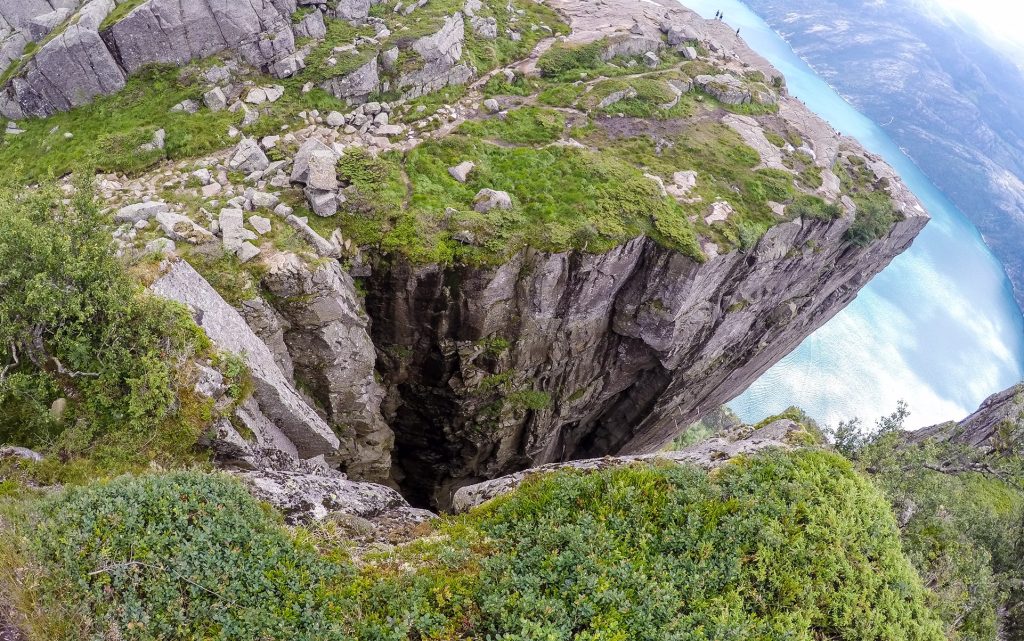
5. How to Get to Pulpit Rock, Norway?
Preikestolen isn’t the easiest place to reach and Norway is not a cheap country to travel around. You want to plan your route in advance to ensure you reach the rock without too much hassle or money spent!
The Westfjords are a complex maze of mountains, fishing villages, enormous fjords, and inlets of the North Sea. The Norwegians have built a systems of roads, bridges, and ferry terminals to navigate this area and free up some accessibility.
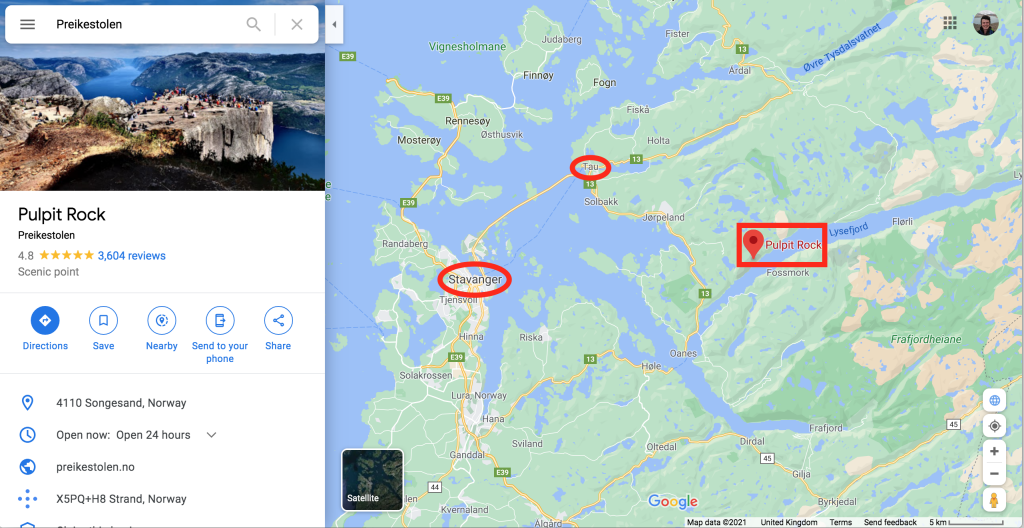
You can either fly to Oslo or Bergen. Both have international airports, and both are cities well worth visiting in their own my right. My itinerary involved taking the train to Oslo (I was interrailing around Europe at the time), then taking the train over to Bergen – on one of the most beautiful train journeys in the world – before taking a bus south to Stavanger.
Stavanger is the closest big settlement to Pulpit Rock, Norway. Stavanger has an airport but it only offers domestic flights. It would be a shame to fly from one of the other Norwegian cities as the overland transport is so exciting. See Skyscanner for flight options.
Once in Stavanger you can take a line 100 bus to Jørpeland before catching a taxi to the Pulpit Rock visitor’s centre. During the peak summer months there is a direct bus from Stavanger to Pulpit Rock. Alternatively, you can take a ferry from Stavanger to Tau as a foot passenger, and then catch a bus from there, followed by another taxi. For bus options see the NOR-WAY Bussekspress website.
As you can probably tell by now, this is a complex journey. Particularly due to a new bridge being built and a variation in options between the seasons. By far the easiest thing to do is hire a car. This gives you freedom to explore the country without having to rely on the inconvenient and expensive public transport!
In my case, I took the ferry from Stavanger to Tau, then wild camped along the coastline to wait for the bus the following morning. The next day I ended up hitchhiking with some Norwegian hikers who kindly took me all the way to the Pulpit Rock car park!
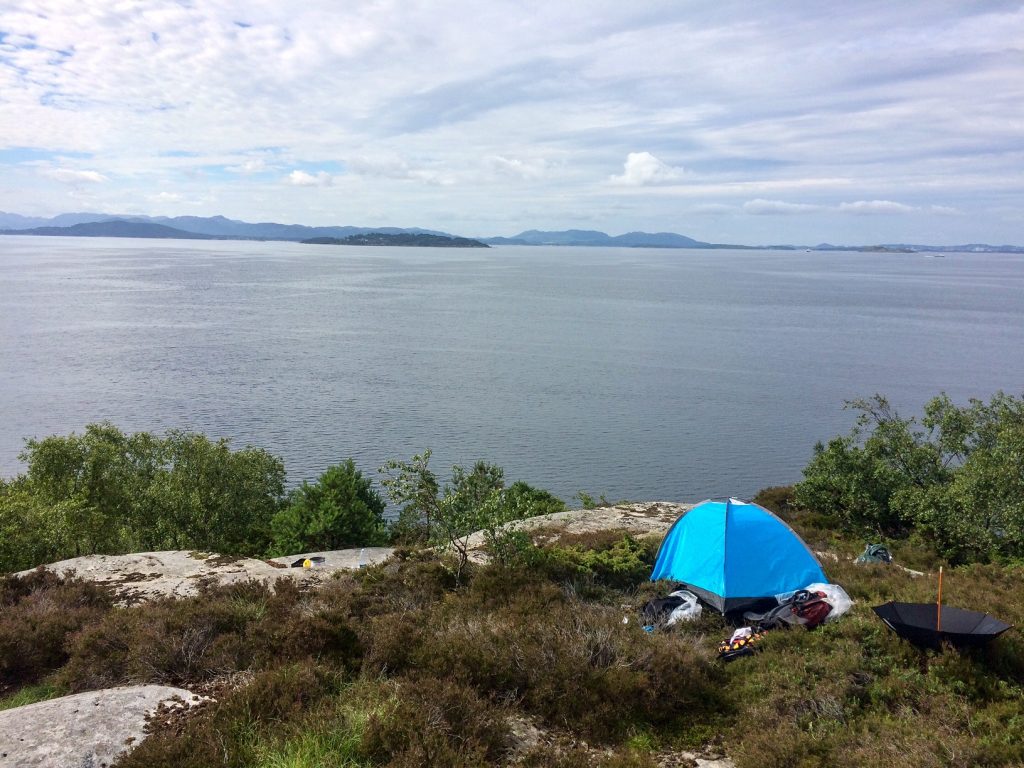
6. What to Pack?
This hike isn’t particularly long and arduous so you don’t need to bring the kitchen sink. But it’s important to pack some essential items in a backpack anyway. If possible, wear layers of clothing that are light and breathable.
Bring a zip-up fleece and a waterproof jacket in case it rains. Carry a sun hat and wear sunglasses in the summer as it’s exposed on the mountains.
See also:
Multi-Day Hike Kit List
Day Hiking Gear Essentials
Make sure you bring enough water for the hike, 1.5 – 2 litres per person, and snacks for the journey. Pick up some nuts, trail mix, or Norwegian hiking chocolate called Kvikk Lunsj before you set off.
Don’t wear clunky hiking boots as you won’t need them. The trail is all along hard stone tracks and wooden paths. Try lightweight trail running shoes or trainers to stop your feet from getting blisters instead!
If you’re camping overnight, bring plenty of water as it’s not easy to fill up once on Pulpit Rock. If you have a water filter, you can refill from mountain streams. Carry a warm hat and gloves as it does get cold up there. Also ensure you have a good sleeping mat as the surface is all cold granite rock!
Before You Go
Thanks for reading my travel guide on Pulpit Rock, Norway. If travel guides like this interest you, head over to my blog page to find out more!
If you’re new to Walk Wild, check out the About Me page to learn who I am and what made me want to be a travel writer.
Please comment below, let me know what you think and if there’s anything else you want information on!
Follow me on Twitter, Instagram, and YouTube to see out more.




